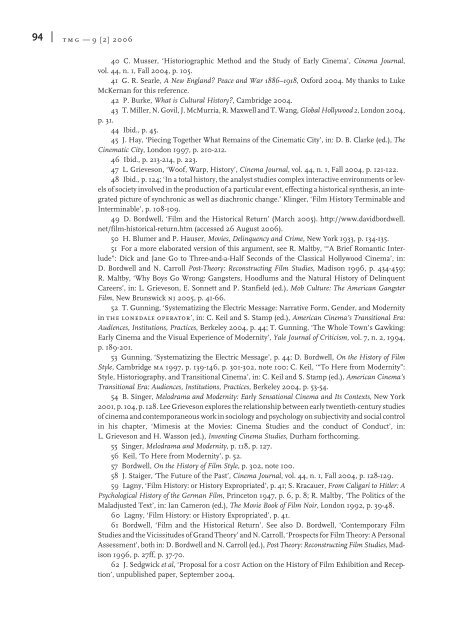Artikel: On the prospect of writing cinema history from below
Artikel: On the prospect of writing cinema history from below
Artikel: On the prospect of writing cinema history from below
You also want an ePaper? Increase the reach of your titles
YUMPU automatically turns print PDFs into web optimized ePapers that Google loves.
94 | tmg — 9 [2] 200640 C. Musser, ‘Historiographic Method and <strong>the</strong> Study <strong>of</strong> Early Cinema’, Cinema Journal,vol. 44, n. 1, Fall 2004, p. 105.41 G. R. Searle, A New England? Peace and War 1886–1918, Oxford 2004. My thanks to LukeMcKernan for this reference.42 P. Burke, What is Cultural History?, Cambridge 2004.43 T. Miller, N. Govil, J. McMurria, R. Maxwell and T. Wang, Global Hollywood 2, London 2004,p. 31.44 Ibid., p. 45.45 J. Hay, ‘Piecing Toge<strong>the</strong>r What Remains <strong>of</strong> <strong>the</strong> Cinematic City’, in: D. B. Clarke (ed.), TheCinematic City, London 1997, p. 210-212.46 Ibid., p. 213-214, p. 223.47 L. Grieveson, ‘Wo<strong>of</strong>, Warp, History’, Cinema Journal, vol. 44, n. 1, Fall 2004, p. 121-122.48 Ibid., p. 124; ‘In a total <strong>history</strong>, <strong>the</strong> analyst studies complex interactive environments or levels<strong>of</strong> society involved in <strong>the</strong> production <strong>of</strong> a particular event, effecting a historical syn<strong>the</strong>sis, an integratedpicture <strong>of</strong> synchronic as well as diachronic change.’ Klinger, ‘Film History Terminable andInterminable’, p. 108-109.49 D. Bordwell, ‘Film and <strong>the</strong> Historical Return’ (March 2005). http://www.davidbordwell.net/film-historical-return.htm (accessed 26 August 2006).50 H. Blumer and P. Hauser, Movies, Delinquency and Crime, New York 1933, p. 134-135.51 For a more elaborated version <strong>of</strong> this argument, see R. Maltby, ‘“A Brief Romantic Interlude”:Dick and Jane Go to Three-and-a-Half Seconds <strong>of</strong> <strong>the</strong> Classical Hollywood Cinema’, in:D. Bordwell and N. Carroll Post-Theory: Reconstructing Film Studies, Madison 1996, p. 434-459;R. Maltby, ‘Why Boys Go Wrong: Gangsters, Hoodlums and <strong>the</strong> Natural History <strong>of</strong> DelinquentCareers’, in: L. Grieveson, E. Sonnett and P. Stanfield (ed.), Mob Culture: The American GangsterFilm, New Brunswick nj 2005, p. 41-66.52 T. Gunning, ‘Systematizing <strong>the</strong> Electric Message: Narrative Form, Gender, and Modernityin <strong>the</strong> lonedale operator’, in: C. Keil and S. Stamp (ed.), American Cinema’s Transitional Era:Audiences, Institutions, Practices, Berkeley 2004, p. 44; T. Gunning, ‘The Whole Town’s Gawking:Early Cinema and <strong>the</strong> Visual Experience <strong>of</strong> Modernity’, Yale Journal <strong>of</strong> Criticism, vol. 7, n. 2, 1994,p. 189-201.53 Gunning, ‘Systematizing <strong>the</strong> Electric Message’, p. 44; D. Bordwell, <strong>On</strong> <strong>the</strong> History <strong>of</strong> FilmStyle, Cambridge ma 1997, p. 139-146, p. 301-302, note 100; C. Keil, ‘“To Here <strong>from</strong> Modernity”:Style, Historiography, and Transitional Cinema’, in: C. Keil and S. Stamp (ed.), American Cinema’sTransitional Era: Audiences, Institutions, Practices, Berkeley 2004, p. 53-54.54 B. Singer, Melodrama and Modernity: Early Sensational Cinema and Its Contexts, New York2001, p. 104, p. 128. Lee Grieveson explores <strong>the</strong> relationship between early twentieth-century studies<strong>of</strong> <strong>cinema</strong> and contemporaneous work in sociology and psychology on subjectivity and social controlin his chapter, ‘Mimesis at <strong>the</strong> Movies: Cinema Studies and <strong>the</strong> conduct <strong>of</strong> Conduct’, in:L. Grieveson and H. Wasson (ed.), Inventing Cinema Studies, Durham forthcoming.55 Singer, Melodrama and Modernity, p. 118, p. 127.56 Keil, ‘To Here <strong>from</strong> Modernity’, p. 52.57 Bordwell, <strong>On</strong> <strong>the</strong> History <strong>of</strong> Film Style, p. 302, note 100.58 J. Staiger, ‘The Future <strong>of</strong> <strong>the</strong> Past’, Cinema Journal, vol. 44, n. 1, Fall 2004, p. 128-129.59 Lagny, ‘Film History: or History Expropriated’, p. 41; S. Kracauer, From Caligari to Hitler: APsychological History <strong>of</strong> <strong>the</strong> German Film, Princeton 1947, p. 6, p. 8; R. Maltby, ‘The Politics <strong>of</strong> <strong>the</strong>Maladjusted Text’, in: Ian Cameron (ed.), The Movie Book <strong>of</strong> Film Noir, London 1992, p. 39-48.60 Lagny, ‘Film History: or History Expropriated’, p. 41.61 Bordwell, ‘Film and <strong>the</strong> Historical Return’. See also D. Bordwell, ‘Contemporary FilmStudies and <strong>the</strong> Vicissitudes <strong>of</strong> Grand Theory’ and N. Carroll, ‘Prospects for Film Theory: A PersonalAssessment’, both in: D. Bordwell and N. Carroll (ed.), Post Theory: Reconstructing Film Studies, Madison1996, p. 27ff, p. 37-70.62 J. Sedgwick et al, ‘Proposal for a cost Action on <strong>the</strong> History <strong>of</strong> Film Exhibition and Reception’,unpublished paper, September 2004.
















